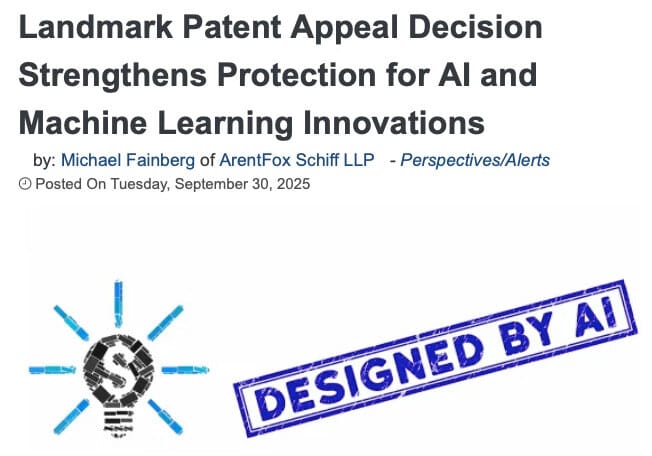- Pascal's Chatbot Q&As
- Posts
- By affirming that AI training methods can embody technological improvements rather than mere abstract ideas, the USPTO has opened the door for more robust, reliable IP protection in machine learning.
By affirming that AI training methods can embody technological improvements rather than mere abstract ideas, the USPTO has opened the door for more robust, reliable IP protection in machine learning.
For AI makers, patents are once again a viable moat. For rights owners, an escalation in the importance of IP strategy: AI techniques become assets as critical as the data they are trained on.
A Landmark in AI Patentability: Why the DeepMind Decision Matters
by ChatGPT-4o
The September 26, 2025 decision by the USPTO’s Appeals Review Panel (ARP) in Ex parte Desjardins et al.—a case centered on DeepMind’s method for training machine learning models—is more than a procedural win for one company. It represents a watershed moment in how the United States patent system treats artificial intelligence innovations.
What the Case Was About
DeepMind’s patent application (16/319,040) covered a method for continual training of machine learning models across multiple tasks. The invention tackled a well-known AI challenge: catastrophic forgetting, where models lose performance on older tasks when trained on new ones. DeepMind’s method computed parameter importance, then used a penalty function to preserve prior learning while optimizing for new tasks.
The Board of Appeals had originally rejected the claims under § 101 (patent eligibility), saying the method amounted to an abstract mathematical calculation. DeepMind pushed back, arguing that the claims didn’t just recite math but implemented a concrete technological solution to improve machine learning systems. The ARP agreed, vacating the § 101 rejection while leaving obviousness (§ 103) issues intact.
Why It’s Important
A Precedent for AI Patent Eligibility
The ARP held that while the claims involved mathematical steps, they integrated those steps into a practical application that improves computer functionality itself—reduced storage needs, preserved task performance, and lower system complexity. This aligns AI innovation with earlier software-eligibility cases like Enfishand McRO, confirming that not all algorithms are doomed to fail under Alice.Shifting Away From Overbroad § 101 Exclusions
The decision criticized panels that lump all AI techniques under “unpatentable algorithms.” It emphasized that §§ 102, 103, and 112—not § 101—should be the main filters for AI inventions. That means novelty, non-obviousness, and adequate disclosure will decide the scope of protection, not a blunt “abstract idea” rule.Policy Signal From USPTO Leadership
Because this was not just a routine panel but an ARP led by the USPTO Director himself, the message is deliberate: the U.S. patent system will support AI innovation. This reassures investors and companies that their R&D in machine learning methods can be secured as IP, boosting confidence in patent filings.
What AI Companies Should Note
File Early and Broad: The decision shows the USPTO is open to recognizing technical improvements in AI. Companies should aggressively pursue protection for training methods, continual learning strategies, and system-level optimizations.
Frame Claims as Technical Solutions: Applicants must highlight improvements to system performance, memory efficiency, or computational function, not just abstract math. How the invention fixes a real computer science problem should be front and center.
Expect Obviousness Battles: While eligibility hurdles may be lower after this ruling, rejections under §§ 102 and 103 will become the battleground. Firms must prepare stronger arguments on novelty and inventive step.
What IP Rights Owners Should Note
New Competitive Landscape: Patent portfolios in AI training could become as valuable—and contested—as chip design patents. Rights owners should anticipate a surge in AI patent filings and prepare for more licensing negotiations and litigation.
Interoperability Concerns: Proprietary rights over training methods could affect cross-compatibility in AI systems. Content owners should watch closely how patents intersect with copyright licensing, especially if patented training methods rely on large datasets.
Regulatory Leverage: The USPTO’s stance strengthens the U.S. position globally. For rights owners, this creates opportunities to push for reciprocity in other jurisdictions—ensuring AI inventions are protected abroad as well.
Conclusion
The DeepMind rehearing decision is not just about one patent; it’s about the patent system catching up with the AI age. By affirming that AI training methods can embody technological improvements rather than mere abstract ideas, the USPTO has opened the door for more robust, reliable IP protection in machine learning. For AI companies, this means patents are once again a viable moat. For rights owners, it signals an escalation in the importance of IP strategy—one where AI techniques themselves become assets as critical as the data they are trained on.
In short: this decision sets the foundation for the next decade of AI innovation, litigation, and licensing. Ignore it at your peril.
